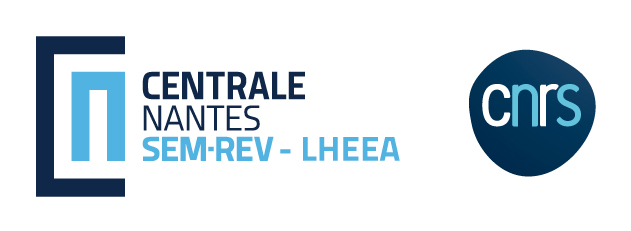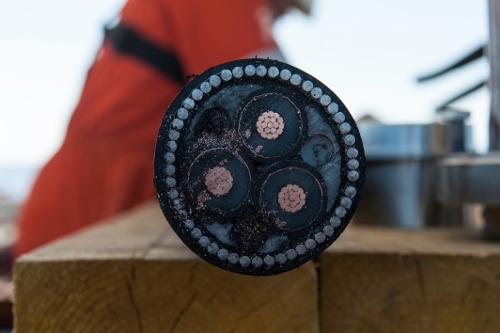
Background
Marine renewable energy (MRE) is an interesting sustainable source of power for the future electric networks. However, planning the integration of MRE in the energy mix with a cost-effective point of view is always a challenge compared to conventional sources of energy. The marine environment complexity requires prototyping and testing stages at sea for new technologies development: this is the purpose of the SEM-REV marine platform. With 1 km² of dedicated sea space and an 8 MW submarine connection cable, the platform allows testing and validation of prototypes up to scale 1. SEM-REV is currently hosting FLOATGEN, the first French floating wind turbine, and the wave energy converter WAVEGEM installed within the IHES project.
The next step is to integrate on the site new MRE technologies (fixed wind turbines, wave energy or hybrid systems, etc.) and storage solutions by adding a floating electrical substation. This new platform at SEMREV will be a support to allow researchers and specialists to test and validate innovative marine electrical architectures, methods of diagnosis and monitoring, sensors and measurement systems.
The ORIGAMI global project provide a long-term structuring framework for this phase of valorization and development of the SEM-REV platform, a phase that requires in the short term a strong collaboration between Centrale Nantes (LHEEA) hydrodynamics specialists, and electrical specialists from Université de Nantes (IREENA), Université de Rennes (SATIE) and CEA-Tech.
Scientific advances and innovation
The ORIGAMI project will address the integration of MRE energy production from a multidisciplinary point of view, including mainly hydrodynamics, electrical engineering, environmental monitoring and modeling. The ORIGAMI project relies on three main pillars:
• Acquisition of unique feedback from SEM-REV infrastructures
• Modeling the entire electrical chain
• Integration of next generation components and methods for testing innovative storage, monitoring and hybrid systems.
For the WEAMEC-2019 call for projects, the ORIGAMI project aims to initiate collaboration and address several issues:
- Define how to manage the electrical co-activity on hybrid production farms: development of the specifications for the electrical sub-station which will be deployed in 2020 by the development of a Wave-to-Wire simulation model, based on the results of the SeaStorage project.
- Monitoring of critical infrastructures such as cable: development of an umbilical diagnostic device prototype based on parameters identification, in the time domain, of a multi-line transmission type model. The model was validated previously in the ANR EMODI project. This low-cost early detection system for the umbilical sealing barrier rupture is intended to be installed on the wind turbine and / or the electrical substation.
- Evaluate the possibility of optimizing the existing electrical infrastructures and quantifying the optimized power, which is the logical continuation of the BlueGrid project, led by SATIE, in collaboration with IREENA, following previous collaboration in the ANR EMODI project.
The project proposes a strong collaboration between the laboratories and relies on the unique expertise of IREENA, SATIE and CEA TECH in electrical engineering and LHEEA in ocean engineering. The project enables to cover the entire conversion chain using a holistic and experimental approach using the the SEANergy platform of CEA Tech and the SEM-REV site, operated by Centrale Nantes.
Expected technical and economic impact
- Demonstration of electrical infrastructures, mainly the SEM-REV export cable, at more than 8MW (original design purpose) thanks to the models and real SEM-REV data in operation
- The project will develop and validate the umbilical diagnostic equipment developed by IREENA as part of the EMODI project, with successful integration on the electrical substation
- Development of specifications for a floating electrical laboratory to test innovative conversion and storage architectures, as well as monitoring equipment
- Start of two theses between 2021 and 2022 or definition of several research projects for future collaborations between SEM-REV, IREENA and CEA-TECH
Key project milestones
- November 2019 - Kick-off meeting
- November 2020 - Umbilical diagnostic prototype integrated and transportable
- march 2021 - Experimental calibration of the W2Wire model
- June 2021 - SEMREV site test report
- November 2021 - Floating substation specifications
- November 2021 - End of the project
Demonstrator
Prototype of a diagnostic device for early detection of the umbilical sealing barrier rupture.
Results
Wave/Wind to Wire modelling – Preliminary results
- Full functional definition of the tool (including mission, stakeholders)
- Complexity to accommodate different time stamps
- A preliminary model based on IREENA/SATIE models, with the ambition to calibrate losses based on SEMREV monitoring data, but using open models to allow publications
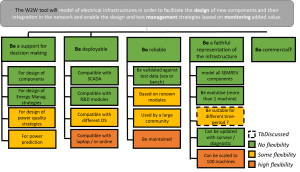
Development and calibration of an umbilical diagnostic device for Low-cost early detection
Preliminary results
- Description of the theory behind the linearization and identification of models for the detection between screens of the evolution of the capacity linked to a detection of water ingress.
- Verification against COMSOL model with progressive water ingress
- Early stage experimental validation (using a sample of SEMREV export cable)
- Specification of the diagnostic device
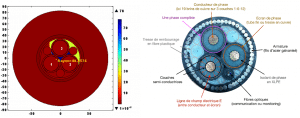
ORIGAMI considers thermal analysis instead of more classical current limitation for the purposes of maximizing the usage of the existing infrastructures of the SEM-REV.
- Case study is based on a wave farm that could be installed in the vicinity of the SEM-REV test site.
- Number of wave energy converter () can be optimised using the constraints:

- Techno-economical perspectives
First results: The analyzes of preliminary studies over 10 months of operation show that production can increase by 10 to 20% with a limitation in temperature rather than in current.
> See the paper: C.-H. Bonnard; A. Blavette; Salvy Bourguet; Thomas Soulard; Yves Perignon. “Near-optimal use of a MRE export cable considering thermal and techno-economic aspects” ISGT EU 26-28 Oct. 2020
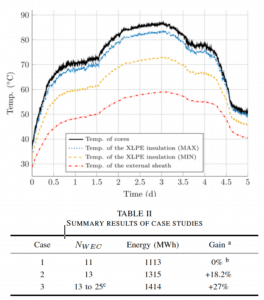
Electrical specifications of the future Equipment of the SEMREV test site: a multi-use Platform.
- Preliminary review of existing paltforms
- Normative context
- Benefiting from AMI Sea-GRID
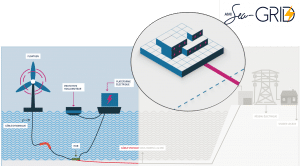
Publications and papers published
Publications
- C.-H. Bonnard, A. Blavette, S. Bourguet, T. Soulard, Y. Perignon. Near-optimal use of a MRE export cable considering thermal and techno-economic aspects, ISGT EU 26-28 Oct. 2020
- A. Matine, E. Schaeffer, C-H. Bonnard, T. Soulard. Diagnosis of dynamic cable water barrier using a model-based approach, SGE 2021 (En cours de soumission)
Oral communications
- C.H. Bonnard, A. Blavette, S. Bourguet, F. Rongère, T. Kovaltchouk and T. Soulard. Increasing the rated power of existing wave test sites thanks to their electrothermal flexibility potential: a techno-economic feasibility study, OCEANEXT 2019

